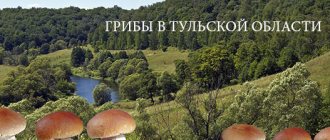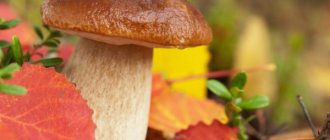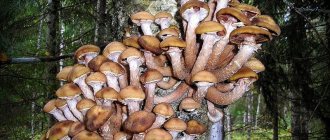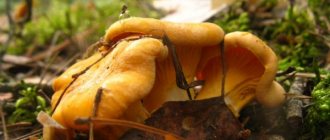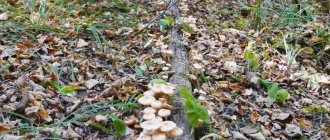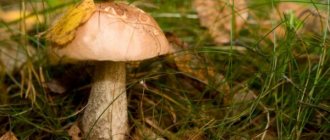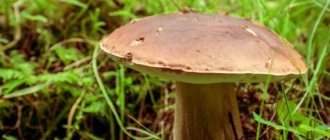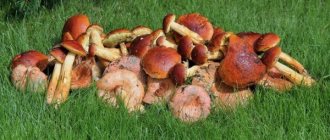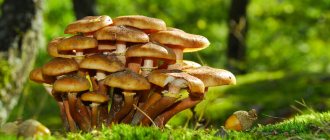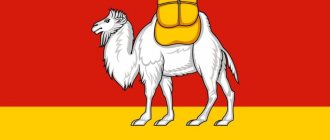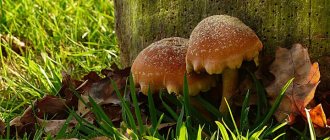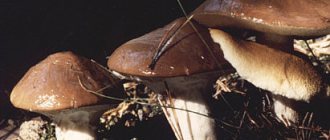Mushrooms
0
2549
Article rating
Kira Stoletova
Mushrooms grow in the Kirov region, depending on the area and weather conditions. Having studied the characteristics of the area, mushroom pickers set out to harvest at any time convenient for themselves.
Mushrooms in the Kirov region
Inedible species
There are also plenty of unedible mushrooms in the forests of the Kirov region. Some include completely edible forest gifts that require careful culinary processing (like morels) and even unusual varieties, such as forest champignons. But we will limit ourselves to mushrooms, which, if they do not cause serious harm to your well-being, will spoil any most appetizing dish with their taste. These include:
Greenfinches are yellow-green mushrooms on a short, almost invisible stalk. Unlike most varieties of "gifts of the forest", greenfinches emerge from the ground during autumn frosts - from September to the end of October. The characteristic bitter taste is felt even if you bite off a tiny piece. At the same time, some extreme sports enthusiasts believe that greenfinches can be cooked by first thoroughly washing and soaking them.
Svinushki are mushrooms that are dangerous to eat even after prolonged soaking, although more recently they were classified as edible species. These fungi are not only toxic, but also absorb all kinds of heavy metals, which turns them into real biological weapons.
chamillionaer
forage.fi
What species grow in the area
Ryzhiki are considered the undisputed symbol of Kirov and the entire region. In addition to saffron milk caps, the region’s mushroom areas are rich in the following species:
- boletus;
- White mushrooms;
- boletus;
- white loader;
- milk mushroom;
- waves;
- chanterelles.
Butter
Butterflies have a shiny, sticky skin that covers the cap. The name of the mushroom is associated precisely with its oily appearance. The fruit bodies are small and medium in size, the cap is hemispherical, covered with a thin skin-film, its maximum diameter reaches 15 cm. When collecting butter, it is very easy to get your hands dirty, because. the pigment contained in the dark-colored skin of the cap very easily “bites” into the skin of the hands and is then very difficult to remove. Therefore, it is better to protect yourself with rubber gloves.
White mushrooms
Porcini mushrooms have a dark brown cap, in places there may be a purple tint, its diameter is 7-30 cm, the flesh is dense, white, juicy, the color remains unchanged. These mushrooms have a delicate and pleasant aroma. The mushroom got its name because its flesh does not change color with any processing method and remains light white. Fans of “quiet hunting” often confuse porcini mushroom with satanic boletus and gall mushroom.
boletus
These mushrooms grow under birch trees, forming mycorrhiza with their roots. Distributed in deciduous forests, on hills, and light edges. The color of the boletus cap is white to dark brown; it can be sticky. The pulp is white, dense, and darkens when cut. The diameter of the cap is up to 18 cm. Boletus mushrooms are also often called “grandmothers”. These mushrooms belong to the genus Leccinum or Obabok. For boletus mushrooms, as well as for porcini mushrooms, there are doubles. In boletus it is a gall fungus.
Loader white
The cap is white, matte, dry, up to 20 cm in diameter. The young white cape has a compressed cap, while the adult has funnels. The leg resembles a cylinder and grows in forest areas.
Irina Selyutina (Biologist):
This species is popularly called “dry milk mushroom” or “crusher”, although it is this species that, despite its external resemblance to milk mushrooms, has nothing to do with them and does not belong to the Milky Way genus. This species does not have milky sap. As the mushroom develops, its cap changes its shape and color. Young specimens are characterized by a convex cap with rolled edges. Mushroom pickers also call it “weak felt”. Then, spots begin to appear on its surface. At first they have a vague yellowish color, which gradually turns into an ocher-rusty color. In addition, forest debris and dirt constantly fall on the cap, and it further changes its color. The mushroom is considered a conditionally edible mushroom, which can be used for food only after preliminary boiling for 15, or better yet, 20 minutes.
Representatives of this species can be found on the edges of all types of forests. It is often found next to deciduous trees: birch, alder, aspen, beech or oak, as well as near spruce or pine.
Gruzd
Milk mushrooms are often found near birch trees - it is with this tree that the milk mushroom enters into a symbiotic relationship and forms mycorrhiza. They are characterized by a yellow funnel-shaped cap and a light cylinder-shaped stem. Milk mushrooms begin to be collected from the moment when the air temperature at the soil surface drops to +10℃ and moderate humidity is observed, because Excess moisture inhibits the development of fruiting bodies.
Milk mushrooms usually grow under a layer of leaf litter, so they are difficult to see. They are usually looked for with a stick, but you need to be careful not to damage them:
- mushroom cap;
- underground mycelium - then you will not find milk mushrooms in this place for a long time, because the mushroom will need time to restore the “functionality” of the mycelium.
Volnushki
Volnushki are classified as conditionally edible mushrooms. They require certain processing. They should be soaked in water: this will remove the bitterness. Subject to salting. The most attractive for mushroom pickers are pink volushka and white volushka. These mushrooms belong to the genus Milky. They settle in forests where birch trees are necessarily present, because it is with them that they form mycorrhiza (mainly with mature trees).
Chanterelles
Chanterelles are never damaged by worms. This happens due to the presence in their pulp of a specific compound - quinomannose, a natural anthelmintic that can destroy not only parasites, but even their eggs. Mushrooms are easy to see under the leaves due to their bright color. The cap and the leg form one whole - to be more precise, the cap smoothly flows into the leg, and the thick folds descending onto it, acting as plates of the hymenophore, simply smooth out this boundary and it is very difficult to see it. The diameter of the cap is up to 12 cm. The shape is irregular, concave or pressed inward, the flesh is fleshy and dense.
Poisonous mushrooms
The candidates for poisonous mushrooms cause less disagreement among mushroom pickers, doctors, and biologists. These include all kinds of fly agarics - from brightly colored to pale yellow and completely pale, as well as the deadly dangerous pale toadstool .
1-Spring fly agaric. 2-The fly agaric is smelly. 3-Pale grebe.
Toxins also contain cleverly disguised “doubles” of edible mushrooms - false honey mushrooms, chanterelles, russula and the like. As a rule, they differ from their beneficial “relatives” by a mealy odor, pulp that darkens or turns blue when broken, or caps that are too brittle (see description of false chanterelles).
a_strange_forest
rkraftyx
mushrooms_inigo
setasetatop
Edible mushrooms
In the forests here you can find many types of edible mushrooms, but not all of them are liked by local residents.
It is noteworthy that the camelina has been on the podium for a long time.
Also among the favorites are white boletus, boletus, boletus, and oiler, and they usually bear fruit abundantly.
Because of the wealth of the leaders, simpler and more modest representatives of the mushroom kingdom remain without special attention - these are morels, strings, russula, pigs, bitters and others.
Volnushki and honey mushrooms do not produce a good harvest every year, but they are also in demand.
Saffron milk caps
You need to look in coniferous forests. They especially like to settle in young plantings of spruce and pine.
Ryzhiki are universal in their use: they can be salted, pickled, and fried. They are good in any form. In their favorite places they grow in huge quantities. Do not forget that these mushrooms secrete a brightly colored (yellow or reddish) milky juice. This will prevent it from being confused with the pink wave.
White
In some years, their yield is such that it is impossible to drive a car along a forest road without crushing a dozen.
Boletus mushrooms grow in mixed and pine forests. You need to look among moss, ferns, you can find them in hazel trees. There are many known forms of porcini mushroom, which differ in the fruiting season, climate characteristics and the formation of mycorrhiza.
Boletus and boletus
Look for them under the trees of the same name. They are bad conspirators: the red caps of the boletus and the brown caps of the boletus rise on high legs and are visible from afar.
Butter
They prefer open, sunny places rather than forests; they grow in forest fires, edges and clearings.
Butterflies are divided into groups according to structural features and symbiont trees:
- Group 1 (typical boletus). Characteristically, there are warts on the stalk and the formation of mycorrhiza with pine trees or some other conifers, excluding larch. Thus, they are confined to two-coniferous pines (Scots pine) or five-coniferous pines (elfin pine, Siberian cedar). These include: yellow m., granular m., white m., cedar m., Siberian m., yellowish m.
- Group 2. Representatives more or less deviate in appearance from typical butterflies. Therefore, for one reason or another, they are often included in other genera. They do not have warts on their legs. Thus, yellow-brown oiler and dry oiler (goat) form mycorrhiza with Scots pine. Their caps are dry in dry weather, but slimy in damp weather. They are also characterized by the absence of a ring on the stem. The other 4 species of this group (M. larch, M. gray, M. red-red, M. remarkable) form mycorrhiza only with larch.
The shape of the cap of these mushrooms changes with growth from convex to flat. In young specimens it is sticky.
Volnushki
In some Western countries (France, Czech Republic) they are classified as poisonous.
But in Russia many people use them successfully. In the Kirov forests, volnushki are also in demand. In appearance they resemble young milk mushrooms. Due to the presence of caustic milky juice, they are not very highly valued by many mushroom pickers.
Mushrooms are intended for pickling after soaking. They grow on sandy and siliceous soils and love the proximity of birches.
Honey mushrooms
They are found in large groups on stumps and fallen trees. They like low places and ravines. Honey mushrooms are popularly called a group of mushrooms from different genera and families precisely because of their habitat - dead wood and stumps.
Milk mushrooms
There are both white (real) and black here. Good for pickling after soaking. You need to look for them in mixed and deciduous forests; they gravitate towards birches. They secrete a caustic milky sap that can change color when exposed to air.
Chanterelles
They grow in huge quantities in the local forests. The attitude towards them is ambiguous: due to the abundance of more valuable mushrooms, not all mushroom pickers collect them. Insect larvae do not like them due to the presence of quinomannose in the pulp.
Where to collect
The most reliable mushroom places in these parts:
- the outskirts of the city of Sovetsk, where many milk mushrooms grow;
- Urzhumsky district is the birthplace of Sergei Kirov and the kingdom of porcini mushrooms;
- pine forests near Belaya Kholunitsa and the settlement of Nolinsk, which are preferred by saffron milk caps.
Flag of the Kirov region.
Mushroom picking in the Kirov region
When collecting mushrooms, you must follow these tips:
- collect them from 6-7 am (the best time is when the mushrooms are still “fresh” after the night);
- carry out primary processing at the collection site;
- process the harvest immediately after returning home;
- carry out additional checks when cleaning, as there are poisonous species in the area;
- Store mushrooms in the refrigerator or immediately can them, marinate, or fry.
It is not allowed to collect unfamiliar species: this can lead to poisoning, because in the forest you can find edible and poisonous species. Only unovergrown and young mushrooms can be collected. They should be collected away from roads and city parks: in such places mushrooms usually accumulate toxic elements.
Mushroom places
Lovers of quiet hunting actively share information on the Internet about mushroom places in their region; there is even a mushroom picking club (closed VK group). Look for mushrooms in the forests near the following settlements:
- Rechnoy, Torfyanoy, Kstinino (near Kirov) - all types of mushrooms;
- White Kholunitsa - milk mushrooms, white mushrooms, saffron milk caps;
- Bobino - saffron milk caps;
- Bogorodskoye - white, saffron milk caps;
- Borisovo - saffron milk caps;
- Ganino - all types;
- Kilmezi - white;
- Kostelnich - saffron milk caps;
- Kyrchany - saffron milk caps;
- Michurinsky - saffron milk caps;
- Nagorsk - milk mushrooms;
- Nema - white;
- Oricha - chanterelles;
- Rainbow - all types of mushrooms;
- Sovetsk - milk mushrooms;
- Suna - white, saffron milk caps;
- Sunchikha - milk mushrooms;
- Yanolinsk - white.
In addition, for whites you can go to the Urzhumsky district, for whites and saffron milk caps - to Yuryansky, for saffron milk caps - to Kirovo-Chepetsky. Saffron milk caps grow along the highways to Sovetsk and Nizhne-Ivkino.
In what places in Kirov and the Kirov region do saffron mushrooms grow?
Before you find out in what places in Kirov saffron milk caps grow, you should pay attention to their appearance so as not to confuse them with false doubles.
The most popular saffron milk caps are spruce, real and red. These mushrooms are red in color with greenish streaks on the surface of the cap. Their bodies are quite fragile, with a hollow stalk; when pressed or cut, a milky juice is released, which turns green or blue.
Although saffron milk cap is considered the king of pickles, it is suitable for all types of preparation: pickling, freezing, drying, frying.
Kirov mushroom pickers assure that if the spring and summer were rainy and warm, then in the fall there will be as many saffron milk caps as you can see. You can find out where saffron milk caps grow in the Kirov region from the following information.
Mushrooms are collected in large quantities in the forests of the Yuryansky and Murashinsky districts. Autumn saffron milk caps are especially prized, with peak harvest in mid-September. Even during the time of the Russian tsars, saffron milk caps from the Kirov region were supplied to the imperial court. Mushrooms were always collected small, elastic and beautiful. At the royal court, dishes made from saffron milk caps were highly valued.
